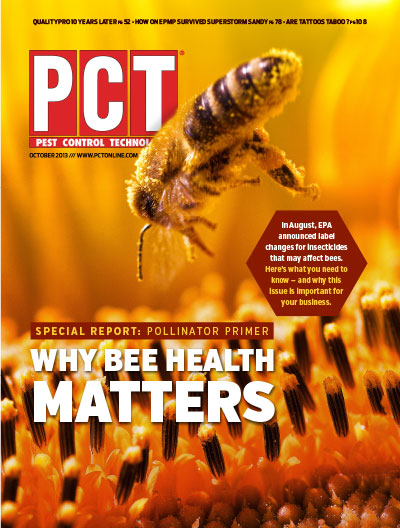 Spiders are the No. 1 fear of many people. People are more upset about seeing spiders than seeing mice, birds, flies, cockroaches or other public health pests. Illogically, most humans fear that spiders will attack without provocation, sinking their poisonous fangs into any adult or child in close proximity, and that the resulting spider bite will be painfully fatal. Knowledgeable PMPs are unable to convince some people otherwise, or that mice, flies and many other indoor pests are a greater human health threat than spiders, mainly due to contamination of food.
Spiders are the No. 1 fear of many people. People are more upset about seeing spiders than seeing mice, birds, flies, cockroaches or other public health pests. Illogically, most humans fear that spiders will attack without provocation, sinking their poisonous fangs into any adult or child in close proximity, and that the resulting spider bite will be painfully fatal. Knowledgeable PMPs are unable to convince some people otherwise, or that mice, flies and many other indoor pests are a greater human health threat than spiders, mainly due to contamination of food.
However, some entomologists have questioned the health significance of spider droppings...usually when looking at the mess in the bottom of a container housing a “pet” spider such as a black widow spider (see photo on the right). It doesn’t take very long before the area underneath the “pet” spider looks like the sidewalk underneath a troublesome resident flock of pigeons (which we know is a cause for concern). So, how safe is spider poop?
If any of the common species of spiders that are found near ceilings indoors defecated on food; a food preparation surface; pillows or towels; baby pacifiers or toys; or anything that may possibly contact a person’s mouth, how dangerous is the contamination? How dangerous are spiders living indoors?
Pathogens in Spider Droppings? More than 100 pathogens that cause human diseases have been recovered from filth flies, including several common human pathogens such as Staphylococcus spp., Streptococcus spp., Enterococcus spp., Salmonella spp. and E. coli (White 2006, Butler et al. 2010). There is also research that found pathogenic bacteria in the feces or droppings of flies (Kobayashi et al. 1999).
However, little research has been done characterizing the microbiological inhabitants of spiders and their droppings. More specifically, what happens when a spider feeds on filth flies? Do pathogenic bacteria pass through the spider and land somewhere below the spider? Beyond some people being scared of spiders, is there a public health reason not to tolerate spiders indoors?
Melissa Gaver-Wainwright, an entomology graduate student at Washington State University, conducted some preliminary research to answer these questions. To examine the potential of pathogen transfer from black widow spider (Latrodectus hesperus) waste material, a fecal sample was swabbed from a sterilized container and dipped in a growth medium to increase the number of bacteria in the sample. Then, in order to identify microbes associated with the fecal material, she amplified a conserved region of the 16S rRNA gene with universal bacterial primers. Overall, there were no bacteria identifiable in the spider fecal material.
The results were puzzling. There are studies that have shown that some spiders have antimicrobial properties in their venom (and blood) which may explain the lack of bacteria found. The bacteria shown to be susceptible to these broad spectrum antibacterial peptides include E. coli, Staphylococcus spp., Enterococcus spp., Pseudomonas spp. and others.
Certainly many questions remain, such as whether other species of web-building spiders also would have an absence of bacteria in their droppings or if alternative molecular techniques would produce different results. Control of filth flies may be more important when it comes to safeguarding health than the control of spiders. However, spider droppings indoors, such as those shown in the photo at left, will not be welcomed by anyone.
The author is director of technical support and regulatory compliance for Copesan, Menomonee Falls, Wis. He can be reached at jsargent@giemedia.com.
Copesan is an alliance of pest management companies with locations throughout North America. To learn more, visit www.copesan.com.
Citations:
Butler, J., Garcia-Maruniak, A., Meek, F., and Maruniak, J. 2010. Wild Florida house flies (Musca domestica) as carriers of pathogenic bacteria. Florida Entomologist 93(2): 218-223.
Kobayashi, M., Sasaki, T., Saito, N., Tamura, K., Suzuki, K., Watanabe, H., and Agui, N. 1999. Houseflies: not a simple mechanical vector of enterohemorrhagic Escherichia coli O157:H7. American J. Trop. Med. Hyg. 61:625-629.
White, G.B. 2006. Filth Flies, Significance, Surveillance and Control in Contingency Operations. Armed Forces Pest Management Board. Technical Guide No. 30. Walter Reed Army Medical Center, Washington, D.C. 54 pp.

Explore the October 2013 Issue
Check out more from this issue and find your next story to read.
Latest from Pest Control Technology
- SiteOne Hosts 2024 Women in Green Industry Conference
- Veseris Celebrates Grand Reopening of the Miami ProCenter
- Rollins' 2024 Second Quarters Revenues up 8.7 Percent YOY
- Fleetio Go Fleet Maintenance App Now Available in Spanish
- German Cockroach Control Mythbusting
- Total Pest Control Acquires Target Pest Control
- NPMA Workforce Development Shares Hiring Updates
- Certus Acquires Jarrod's Pest Control





